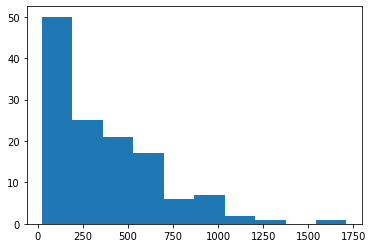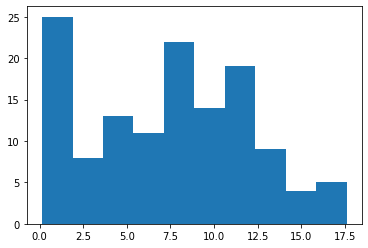Code
import pandas as pd
import numpy as npkakamana
December 27, 2022
Datacamp course: Introduction to Statistic in Python
The study of statistics involves collecting, analyzing, and interpreting data. You can use it to bring the future into focus and infer answers to tons of questions. How many calls will your support team receive, and how many jeans sizes should you manufacture to fit 95% of the population? Statistical skills are developed in this course, which teaches you how to calculate averages, plot relationships between numeric values, and calculate correlations. In addition, you’ll learn how to conduct a well-designed study using Python to draw your own conclusions.
Course Takeaways:
Statistics - what is it?
How can statistics be used?
# Filter for Belgium
be_consumption = food_consumption[food_consumption['country']=='Belgium']
# Filter for USA
usa_consumption = food_consumption[food_consumption['country']=='USA']
# Calculate mean and median consumption in Belgium
print(np.mean(be_consumption['consumption']))
print(np.median(be_consumption['consumption']))
# Calculate mean and median consumption in USA
print(np.mean(usa_consumption['consumption']))
print(np.median(usa_consumption['consumption']))42.13272727272727
12.59
44.650000000000006
14.58 mean median
country
Belgium 42.132727 12.59
USA 44.650000 14.58Mean vs Median

# Calculate the quartiles of co2_emission
print(np.quantile(food_consumption['co2_emission'],np.linspace(0,1,5)))
# Calculate the quintiles of co2_emission
print(np.quantile(food_consumption['co2_emission'],np.linspace(0,1,6)))
# Calculate the deciles of co2_emission
print(np.quantile(food_consumption['co2_emission'],np.linspace(0,1,11)))[ 0. 5.21 16.53 62.5975 1712. ]
[ 0. 3.54 11.026 25.59 99.978 1712. ]
[0.00000e+00 6.68000e-01 3.54000e+00 7.04000e+00 1.10260e+01 1.65300e+01
2.55900e+01 4.42710e+01 9.99780e+01 2.03629e+02 1.71200e+03]A variable’s variance and standard deviation are two of the most common ways to measure its spread, and you will practice calculating them in this exercise. Spread informs expectations. In other words, if a salesperson sells a mean of 20 products a day, but has a standard deviation of 10, they might sell 40 products one day, and one or two the next. Predictions require information like this.
# Print variance and sd of co2_emission for each food_category
print(food_consumption.groupby('food_category')['co2_emission'].agg([np.var,np.std]))
# Import matplotlib.pyplot with alias plt
import matplotlib.pyplot as plt
# Create histogram of co2_emission for food_category 'beef'
plt.hist(food_consumption[food_consumption['food_category']=='beef']['co2_emission'])
# Show plot
plt.show()
# Create histogram of co2_emission for food_category 'eggs'
plt.hist(food_consumption[food_consumption['food_category']=='eggs']['co2_emission'])
# Show plot
plt.show() var std
food_category
beef 88748.408132 297.906710
dairy 17671.891985 132.935669
eggs 21.371819 4.622966
fish 921.637349 30.358481
lamb_goat 16475.518363 128.356996
nuts 35.639652 5.969895
pork 3094.963537 55.632396
poultry 245.026801 15.653332
rice 2281.376243 47.763754
soybeans 0.879882 0.938020
wheat 71.023937 8.427570

Finding outliers using IQR
Outliers can have big effects on statistics like mean, as well as statistics that rely on the mean, such as variance and standard deviation. Interquartile range, or IQR, is another way of measuring spread that’s less influenced by outliers. IQR is also often used to find outliers. If a value is less than Q1−1.5×IQRQ1−1.5×IQR or greater than Q3+1.5×IQRQ3+1.5×IQR, it’s considered an outlier.
country
Albania 1777.85
Algeria 707.88
Angola 412.99
Argentina 2172.40
Armenia 1109.93
...
Uruguay 1634.91
Venezuela 1104.10
Vietnam 641.51
Zambia 225.30
Zimbabwe 350.33
Name: co2_emission, Length: 130, dtype: float64# Calculate total co2_emission per country: emissions_by_country
emissions_by_country = food_consumption.groupby('country')['co2_emission'].sum()
# Compute the first and third quantiles and IQR of emissions_by_country
q1 = np.quantile(emissions_by_country, 0.25)
q3 = np.quantile(emissions_by_country, 0.75)
iqr = q3 - q1
# Calculate the lower and upper cutoffs for outliers
lower = q1 - 1.5 * iqr
upper = q3 + 1.5 * iqr
# Subset emissions_by_country to find outliers
outliers = emissions_by_country[(emissions_by_country > upper) | (emissions_by_country < lower)]
print(outliers)country
Argentina 2172.4
Name: co2_emission, dtype: float64In this chapter, you’ll learn how to generate random samples and measure chance using probability. You’ll work with real-world sales data to calculate the probability of a salesperson being successful. Finally, you’ll use the binomial distribution to model events with binary outcomes